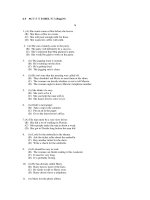Tài liệu Đọc hiểu -TOEFL- Bài 29 pdf
Bạn đang xem bản rút gọn của tài liệu. Xem và tải ngay bản đầy đủ của tài liệu tại đây (79.2 KB, 8 trang )
Reading comprehension -TOEFL- Lesson 29 (Đọc hiểu -TOEFL- Bài 29)
Đọc đoạn văn sau và trả lời các câu hỏi:
Over the past 600 years, English has grown from a language of few speakers to
become the dominant language of international communication. English as we
know it today emerged around 1350, after having incorporated many elements of
French that were introduced following the Norman 5 invasion of 1030. Until the
1600s, English was, for the most part, spoken only in England and had not
extended even as far as Wales, Scotland, or Ireland. However, during the course of
the next two centuries, English began to spread around the globe as a result of
exploration, trade (including slave trade), colonization, and missionary work. 10
Thus, small enclaves of English speakers became established and grew in various
parts of the world. As these communities proliferated, English gradually became
the primary language of international business, banking, and diplomacy.
15 Currently, about 80 percent of the information stored on computer systems
worldwide is in English. Two-thirds of the world's science writing is in English,
and English is the main language of technology, advertising, media, international
airports, and air traffic controllers. Today there are more than 700 million English
users in the world, 20 and over half of these are nonnative speakers, constituting
the largest number of nonnative users than any other language in the world.
1. What is the main topic of this passage?
(A) the number of nonnative users of English
(B) the French influence on the English language
(C) the expansion of English as an international language
(D) the use of English for science and technology
2. The word "emerged" in line 3 could best be re-placed by which of the
following?
(A) appeared
(B) hailed
(C) frequented
(D) engaged
3. As used in line 4, the word "elements" is most similar to which of the
following?
A
B
(A) declaration
(B) features
(C) curiosities
(D) customs
4. The word "extended" as used in line 6 is more similar to which of the
following?
(A) experienced
(B) conferred
(C) spread
(D) stretched
5. Approximately when did English begin to be used beyond England?
C
D
(A) in 1066
(B) around 1350
(C) before 1600
(D) after 1600
6. According to the passage, all of the following contributed to the spread of
English around the world EXCEPT
(A) the slave trade
(B) the Norman invasion
(C) missionaries
(D) colonization
7. As used in line 7, which of the following is closest in meaning to the word
B
"course"?
(A) subject
(B) policy
(C) time
(D) track
8. The word "enclaves" in line 10 could best be replaced by which of the
following?
(A) communities
(B) organizations
(C) regions
(D) countries
C
A
9. The word "proliferated" in line 11 is closest in meaning to which of the
following?
(A) prospered
(B) organized
(C) disbanded
(D) expanded
10. Which of the following is closest in meaning to the word "stored" as used
in line 15?
(A) bought
(B) saved
(C) spent
D
B
(D) valued
11. Which of the following is closest in meaning to the word "constituting" in
line 20?
(A) looking over
(B) setting down
(C) doing in
(D) making up
12. According to the passage, approximately how many nonnative users of
English are there in the world today?
(A) a quarter million
(B) half a million
D
C
(C) 350 million
(D) 700 million









